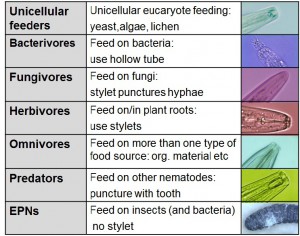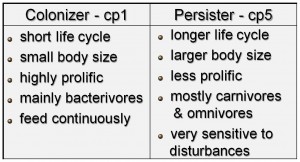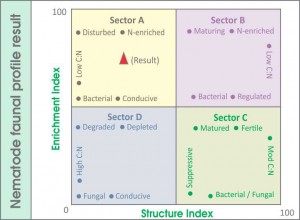Nematodes as bio-indicators of soil health (Microbe-/Bio-test)
Service offered…
nemlab now offers a new service – the Soil Health Bio-test . This test will determine the numbers of each family of free-living nematodes in the soil and following the results a recommendation will be made on how healthy the soil is.
What has to be done…
Send a clearly marked plastic bag containing a soil sample (block/row number) consisting of approximately 2 kg soil and 10g fine roots to nemlab. Complete the FORM and attach it to the outside of the plastic bag. Soil samples should always be taken in the active growing root zone (including fine hair roots) in a sampling area of 3 ha or smaller, and consist of 10-20 thoroughly mixed sub-samples.
How does it work…
A healthy soil is considered to be a stable soil, rich in biological diversity, with high levels of internal cycling of nutrients and with a resilience to stress factors. Nematodes are omnipresent in all soil environments that provide a supply of organic carbon. They occur in habitats that vary from highly polluted to unspoiled, in all types of soil and under any climatic condition.
Soil nematodes occupy key positions in the detritus food web, and can be placed in at least five trophic (feeding) or functional groups (table below). They feed on most soil organisms (fungi, bacteria, nematodes, mites, unicellular algae and lichen) and are also a food source for some of these organisms.
The majority of soil nematodes play a beneficial role in the ecosystem processes and are neither parasites nor pests. Beneficial nematodes play an important role in the soil food web by:
- controlling the cycling of minerals and nutrients,
- controlling the degree of decomposition by regulating the behaviour of the microbial community and
- breaking down organic material into various minerals and organic nutrients.
The nematodes range in their life strategies from explosive colonisers (opportunists) to persisters (conservative survivalists). The scale ranges from early colonizers of extreme enrichment (such as raw manure) to general opportunists (of new resources) to persisters (in undisturbed habitats). Persisters demonstrate a greater sensitivity to pollutants and other disturbances. These strategies and the trophic groups are used to determine various indices.
Colonizer – Persister Scale: cp – value (1-5)
Nematode Indices
One of the key indices of soil health is the measure of disturbance, ie. both stress and/or enrichment. The coloniser-persister scale (cp-values) forms the basis for these indices.
| Structural Index (SI) | Enrichment index (EI) | Channel Index (CI) |
| • Indicates the food web state influenced by stress and disturbance | • Assesses the resources available to Soil Food Web | • Indicates predominant decomposition pathways |
| • > SI > omnivores and predators | • Measure of opportunistic bacterivore and fungivore nematodes | • High value = fungal-dominated decomposers |
| • Suggests more trophic linkages | • Response of primary decomposers to the resources made available | • High cellulose; high lignin; high C: N ratio |
| • Measure of decomposition | • Low value = bacterial-dominated decomposers | |
| • Moist; N-rich tissues |
On the enrichment axis (graph below), functional guild indicators are weighted according to growth and metabolic rates or resource consumption, while the structure axis is weighted according to sensitivity to disturbance.
The Structure Index (horizontal axis) reflects the abundance of resources and where recovery from stress is occurring. The occurrence and profusion of organisms higher up within the trophic level indicates the trophic connectivity of a system. Soil food webs become enriched and the Enrichment index indicates when a disturbance occurs by the addition of a resource. This is a measure of the presence of opportunistic bacterivore and fungivore nematodes.
Nematode faunal profile result




